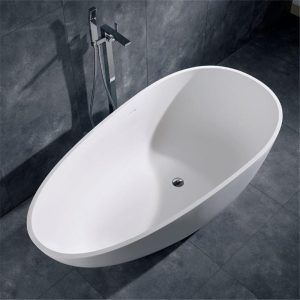Have you ever wondered if you need to do any special maintenance after enjoying a bubble bath in your beloved bathtub? Should your bathtub be composed of marble, you definitely should pay close consideration. Marble baths are beautiful and elegant, but they also require some extra care like sealing. Let’s talk about this topic today: How often should we seal marble bathtubs? Not to panic; I will gently and light-hearted guide you through this problem.

Conteúdo
Why seal marble bathtubs?
First of all, you have to know why you should seal marble bathtubs. Marble absorbs water, oil stains and other liquids since it is really a porous substance. If it is not sealed in time, these liquids will penetrate into the stone and cause discoloration, stains and corrosion. Once these issues arise, basic cleaning is unable to fix them. Therefore, regular sealing of your marble bathtub helps to maintain its brilliance and beauty for a long period.
So how often should you seal it?
The crucial question now is: how often should you seal your marble bathtub? Actually, since there are so many elements influencing this that there is no one correct solution. Generally speaking, it is recommended to seal it every 6 months to 1 year, but it depends on how your bathtub is used.
If your marble bathtub is used frequently, or you like to use aromatherapy oils, bath salts and other things, the sealing frequency may be higher. Since the chemical elements in these objects might hasten marble’s ageing. Your bathtub can even be kept for more than one year if it is not used regularly and you take proper care of it.
How to judge whether it needs to be sealed?
Here is a simple trick to tell you whether your bathtub needs to be sealed again. All you have to do is drop some water on the marble surface and let some minutes pass. If the water droplets do not penetrate, but remain on the surface to form small water beads, it means that your seal is still effective. It is time to seal it once more, though, if the stone absorbs the water drops and produces a dark watermark.
The steps of sealing are actually very simple
In fact, the process of sealing a marble bathtub is not complicated. All you have to do is pick the appropriate stone sealant and follow the guidelines. The typical procedures consist in:
1. Clean the bathtub: First clean the surface of the bathtub with a mild stone cleaner to ensure that there are no stains and residues.
2. Dry the surface: After cleaning, wait for the surface of the bathtub to dry completely.
3. Apply sealant: Apply the sealant evenly to the marble surface, making sure to cover every corner.
4. Wait for absorption: Allow the sealant to fully absorb, which usually takes a few hours to one night.
5. Wipe off excess sealant: Use a clean cloth to wipe off any unabsorbed sealant to avoid leaving marks.

Common misunderstanding: Is it okay not to seal?
Some people could believe that sealing is a pain or perhaps that it makes no difference whether you seal or not. Here I would like to remind you that although the natural beauty of marble is indeed charming, if it is not sealed and maintained regularly, you will find that its surface will become dull and lose its luster over time, and may even have stains that are difficult to remove. By then, you could have to think about hiring a professional to remodel it, which runs far more than the cost of ordinary sealing!
Tip: How to prolong the sealing effect?
In addition to regular sealing, there are some tips to help you prolong the sealing effect. To help your bathtub remain in the best shape, for instance, try to avoid soaking in toiletries with strong acid and alkali ingredients for a long period; clean and dry the bathtub surface in time after use; and apply a layer of special stone protector to the marble after each use.

The sealing frequency of a marble bathtub is actually determined by many factors. Simple advice is to seal it every six months to one year. Your marble bathtub needs to be not only sealed but also properly maintained in daily usage if you wish it to always be in the greatest shape. This means that your bathtub will keep giving you a lovely bathing experience for next years.
Perguntas Frequentes (FAQ)
Como instalar uma banheira de mármore?
A instalação de uma banheira de mármore requer um planeamento cuidadoso e atenção aos detalhes. Em primeiro lugar, escolha o local certo para a banheira, garantindo que tem uma estrutura forte e não é demasiado pesada. Certifique-se de que o chão é plano para evitar instabilidade e fugas. Mova a banheira com ajuda, de preferência de um profissional, para evitar danos. Instalar o sistema de drenagem, assegurando uma vedação completa e um canalizador profissional para qualquer conhecimento de canalização. Testar o fluxo de água e o sistema de drenagem, assegurando um fluxo de água suave e estabilidade. Vede a banheira com um vedante à prova de água para evitar fugas e garantir uma utilização a longo prazo. Instale a torneira e o chuveiro, assegurando uma interface firme e sem falhas. Adicione elementos decorativos como velas perfumadas, toalhas de banho macias e plantas verdes para uma casa de banho quente e confortável. Considere acessórios como tapetes antiderrapantes e almofadas de banheira para maior conforto. Embora a instalação de uma banheira de mármore possa ser demorada, a experiência de luxo que proporciona vale a pena.

Forte
Olá, sou o autor deste artigo e trabalho neste sector há mais de 16 anos. Se precisar de serviços OEM e ODM para engenharia de pedra e mobiliário de pedra, não hesite em consultar-me.




